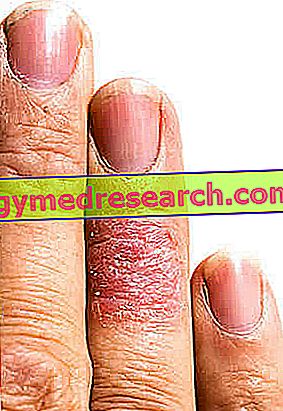What is lymph drainage
Lymphatic drainage is a particular massage technique, exercised in areas of the body characterized by excessive reduction of the lymphatic circulation.
Lymphatic drainage, as the word suggests, promotes the drainage of lymphatic fluids from the tissues: manual mechanical action is exercised at the level of areas that affect the lymphatic system (composed of spleen, thymus, lymph nodes and lymph nodes), in order to facilitate the flow of stagnant organic liquids.

Indications
As mentioned, the purpose of lymphatic drainage is to make the lymphatic fluids flow (thus, drain). For this reason, this particular massage technique is indicated and successfully used for:
- Promote the reabsorption of edema;
- Adjust the neurovegetative system;
- Promote the healing of ulcers and sores in diabetics.
Furthermore, lymphatic drainage is widely used in the field of aesthetic medicine. Not surprisingly, there are many women who use this type of massage to fight cellulite.
Again, treatment with lymph drainage is often recommended for patients who have undergone cosmetic surgery, such as liposculpture and liposuction.
Finally - given its ability to eliminate fluid retention, favoring the reabsorption of edema - lymphatic drainage is a particularly useful technique and is also indicated in pregnant women (for more information: Lymphatic drainage in pregnancy).
History
The "discovery" of lymphatic drainage, as well as the minting of the name "Manual Lymphatic Drainage" (or DLM), are ascribed to the Danish physiotherapist Emil Vodder and his wife Estrid Vodder. However, the basics of this massage technique date back to earlier times.
In fact, it was Dr. Alexander Von Winiwarter - at the end of the nineteenth century - who was the first to introduce a particular and new method of massage in order to counteract the lymphedema. This method involved performing a light massage, followed by compression and, finally, by raising the patient's extremities in order to favor the outflow of lymphatic fluids.
However, this type of massage was not very successful until it was perfected by Dr. Vodder who made it public in 1936.
Starting from this date and for the next 40 years, the Vodders continued their activity as physiotherapists, performing demonstrations and teaching their method. With the passage of time, the number of doctors, masseurs and physiotherapists interested in this innovative massage technique increased more and more, until - in 1967 - the "Society for Manual Lymphatic Drainage of Dr. Vodder" was founded .
Effects and Benefits
Lymphatic drainage carries out its own functions and benefits according to three methods:
- Draining action of liquids: promotes the elimination of interstitial and lymphatic fluids;
- Relaxation activity of muscle fibers;
- Ability to introduce leukocytes and immunoglobulins (produced in the organs of the lymphatic system) in the bloodstream.
All this results in an improvement of the lymphatic circulation and in the consequent well-being of the patient.

Techniques
Lymphatic drainage - contrary to what one might think - is a difficult technique to perform. The operator, in fact, must perfectly know the lymphatic circulation and the areas to be treated: only in this way, the drainage of interstitial fluids and lymph can be favored by the right manipulations. The aim is to direct the lymph towards the lymphatic areas closest to the massaged area: in this way, the superficial circulation of the lymph and its flow is facilitated.
Over time, different techniques have been developed to perform effective lymph drainages.
However, we can say that the methods mainly used are basically two: the Vodder method and the Leduc method .
Methods differ mainly in the type of movements performed, however, they are based on the same fundamental principles.
The lymphatic drainage technique is carried out by applying a slight pressure movement on the skin, which must be slow and delicate, taking care to apply tangential thrusts.
Lymph drainage must follow the path of the lymph: in this regard, the massage requires starting at the level of the neck, an area where the lymph nodes are found where the lymph is mixed with the bloodstream. Only later, the technique proceeds in the other areas of the body.
The Vodder method
The Vodder school provides for the execution of four typical movements: circular thrusts, roundabouts, pumping movements and regulators.
The circular movements, which must always be applied lightly but at the same time consistently, are generally carried out at the level of the neck and face: lymphatic drainage frequently begins with this circular massage, due to the fact that, as mentioned, at the level of the neck the blood and lymphatic circulation mix by means of lymph nodes present in the aforementioned area.
The massage continues with rotatory movements, in which the experienced physiotherapist performs movements with the wrist, raising and lowering it, rubbing the hand on the skin in a circular way.
Subsequently, lymphatic drainage involves pumping movements : tissue pressure is altered to allow better circulation of the lymph (the physiotherapist moves the patient's skin trying to "draw" a sort of oval circles, moving the fingers in the same direction).
All these movements are alternated with a dispensing clutch, which consists of the rotary movement of the wrist on the patient's skin.
The Leduc method
Unlike the Vodder method, the Leduc method involves the execution of a smaller number of movements falling within therapeutic protocols that vary according to the type of disorder that needs to be treated.
There are two movements foreseen by the Leduc method for performing manual lymph drainage:
- The recall maneuver ;
- The reabsorption maneuver .
The recall maneuver must be carried out downstream of the area affected by the disturbance and has the purpose of emptying the lymphatic collectors.
The reabsorption maneuver, instead, is carried out in correspondence of the areas affected by the retention and aims to favor the reabsorption of the liquids inside the superficial lymphatic vessels.

The experience of the masseur
The dexterity of the physiotherapist is certainly a very important factor. With experience, in fact, the specialist refines the ability to apply lymphatic drainage: the massage must follow the lymphatic flow and the friction on the skin must not be too heavy, to prevent the patient perceiving pain; furthermore, the skin must not redden after the session (it is no coincidence that lymphatic drainage is often called "sweet massage").
Only if the physiotherapist applies these basic rules, lymph drainage can perform the desired therapeutic effects.
The masseur, in addition to the aforementioned basic rules, must put into practice some small - but effective - measures, so that the subject can benefit even more from lymph drainage:
- The hands of the physiotherapist must be warm;
- The environment must be suitable: the temperature must not be too hot or cold;
- The patient must be comfortable, the muscles must not be tense, the areas of the body not affected by lymph drainage must be covered;
- The pressure of the massage should increase gradually and, at the end of the massage, the subject should rest for about 15 minutes.
Furthermore, it is essential that the lymphatic drainage is carried out directly with the hands, without the aid of oils or creams, because the contact with the patient's skin must be direct. The creams, on the other hand, would favor the sliding of the hands along the body, while the friction is fundamental to push the skin and the stagnant liquids in an appropriate way.
The pressure exerted by the specialist's hands on the patient's skin must not be excessive, to avoid increasing the passage of liquids from the tissues to the blood vessels but, on the other hand, favor the drainage of lymphatic fluids.
Duration of treatment
It is rare that lymphatic drainage maneuvers can completely resolve the edema and the stagnation of the liquids in a single session. Generally, the patient must undergo multiple treatments to achieve good lasting results. Obviously, the frequency and duration of the sessions will be established based on the patient's disorder.
Contraindications and advice
Like all therapies (since lymphatic drainage is a therapeutic method), there are contraindications: lymphatic drainage is strictly not recommended in people suffering from acute inflammation, malignant tumors, cardiac edema. Even those suffering from blood pressure (hypo / hypertension) should not undergo lymphatic drainage treatments, as well as asthmatic people and women during the menstrual cycle.
It is advisable to practice sports and follow a healthy and regular diet, free from excess and rich in liquids (water), in order to stimulate the metabolism, reactivate the circulation and reduce fat accumulations, favoring water exchange. Through the implementation of these simple measures, lymphatic drainage is certainly favored and can yield good results in a short time.



